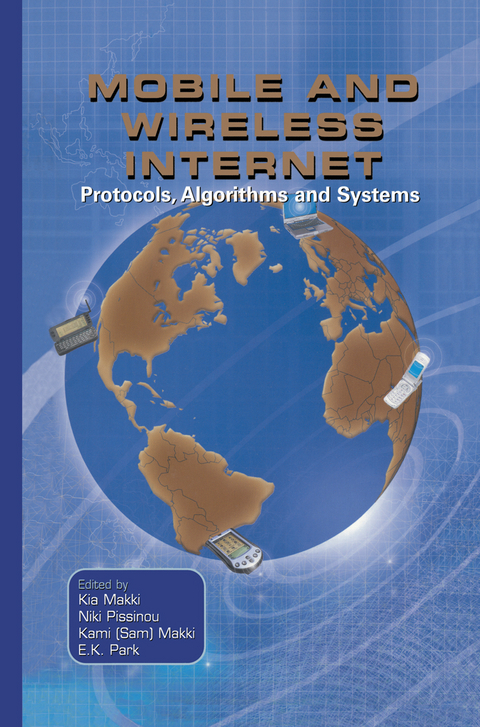
Mobile and Wireless Internet
Springer-Verlag New York Inc.
978-1-4613-4974-7 (ISBN)
Recent advances in mobile and wireless communication and personal computer technology have created a new paradigm for information processing. Today, mobile and wireless communications exit in many forms, providing different types of services. Existing forms of mobile and wireless communications continue to experience rapid growth and new applications and approaches are being spawned at an increasing rate. Recently, the mobile and wireless Internet has become one of the most important issues in the telecommunications arena. The development of the mobile and wireless Internet is the evolution of several different technologies coming together to make the Internet more accessible. Technologies such as the Internet, wireless networks, and mobile computing have merged to form the mobile and wireless Internet. The mobile and wireless Internet extends traditional Internet and World Wide Web services to wireless devices such as cellular phones, Personal Digital Assistants (PDAs) and notebooks. Mobile and wireless Internet c:an give users access to personalized information anytime and anywhere they need it, and thus empower them to make decisions more quickly, and bring them closer to friends, family, and work colleagues. Wireless data communication methods have been around for sometime.
1 Dynamic Configuration of Mobile Devices for Wireless Internet Access.- 1.1 Introduction.- 1.2 Taxonomy of Solutions.- 1.3 Dynamic Configuration Solutions Based on DHCP.- 1.4 Evaluation and Comparison.- 1.5 Related Work.- 1.6 Summary and Conclusions.- References.- 2 Fast Soft Handoff Support and Diffserv Resource Allocation in Wireless Mobile Internet.- 2.1 Introduction.- 2.2 Previous Micromobility Protocols.- 2.3 System Architecture.- 2.4 Mobile Cellular IP (MCIP).- 2.5 DiffServ Registration Domain.- 2.6 Domain-Based Call Admission Control.- 2.7 Adaptive Assured Service.- 2.8 Performance Evaluation.- 2.9 Conclusion and Future Research.- Notes.- References.- 3 Wireless Access of Internet Using TCP/IP.- 3.1 Introduction.- 3.2 Transmission Control protocol (TCP).- 3.3 Wireless Networks.- 3.4 TCP and Wireless Networks.- 3.5 Conclusion.- References.- 4 Mobility Prediction for QoS Provisioning.- 4.1 Introduction.- 4.2 Related Work and Motivation.- 4.3 Mobility Prediction Schemes.- 4.4 Dynamic Resource Reservation Based on Mobility Predictions.- 4.5 Performance Evaluation.- 4.6 Conclusion.- References.- 5 Seamless Mobility.- 5.1 Introduction.- 5.2 Seamless IP Routing Change.- 5.3 Seamless Service Transition.- 5.4 Seamless Intertechnology Handover.- 5.5 Seamless Dormant Mode Location Management.- 5.6 An Internet Without Boundaries.- References.- 6 IP Mobility Protocols for Wireless Internet.- 6.1 Introduction.- 6.2 Macro-mobility Protocols.- 6.3 Micro-mobility Protocols.- 6.4 Comparison of micro-mobility protocols.- 6.5 Conclusion.- References.- 7 An Initial Security Analysis of the Personal Transaction Protocol.- 7.1 Introduction.- 7.2 PTP Description.- 7.3 Assets, Risks and Threats.- 7.4 PTP Technical Analysis.- 7.5 Conclusions and recommendations.- References.- 8 Node-Centric Hybrid Routing for Wireless Internetworking.- 8.1 Introduction.- 8.2 Node Centric Hybrid Routing.- 8.3 Hybrid Routing Using SOAR.- 8.4 Multiple Netmark Scenarios.- 8.5 Performance Evaluation.- 8.6 Conclusions.- References.- 9 Mobile Multicast.- 9.1 Introduction.- 9.2 Basic Assumptions Influencing TCP/IP.- 9.3 IP Multicast.- 9.4 IP Mobility protocols.- 9.5 Transcoding Filters.- 9.6 Combining IP Multicast and Mobility.- 9.7 New Perspectives on Mobile Multicast.- 9.8 Conclusions.- References.- 10 Multipath Routing In Ad Hoc Networks.- 10.1 Introduction.- 10.2 Design Space for Ad Hoc Multipath Routing Protocols.- 10.3 Examples of ad hoc multipath routing approaches.- 10.4 Recent advances in ad hoc multipath routing protocols.- References.- 11 Competitive Analysis of Handoff Rerouting Algorithm.- 11.1 Introduction.- 11.2 The Network Model.- 11.3 Existing Handoff Rerouting Schemes.- 11.4 Handoff Anticipating Algorithms.- 11.5 Handoff Non-Anticipating Schemes.- 11.6 Simulation Results.- 11.7 Conclusions and Future Work.- References.- 11.A The Proof of Theorem 3.- 11.B The Competitive Ratio of Algorithm.- 12 Cache-Based Compaction.- 12.1 Introduction.- 12.2 Related Work.- 12.3 Our Cache-based Compaction Technique.- 12.4 Applying Compaction to Web Transfer.- 12.5 Applying Compaction to Email Transfer.- 12.6 Conclusion.- References.- 13 Performance Improvments in Multi-Tier Cellular Networks.- 13.1 Introduction.- 13.2 Network Architecture and Problem Statement.- 13.3 Modeling Assumptions and Performance Metrics.- 13.4 Analysis of the Network with a Single Class of Traffic.- 13.5 Two-Tier Cellular Network without Handoff Overheads.- 13.6 Two-Tier Cellular Network with Handoff Overheads.- 13.7 Sensitivity of Results to Parameters.- 13.8 Related Work.- 13.9 Conclusion and FutureWork.- References.- 14 Technology-Independent Link Sensing in Wireless Ad-Hoc Networks: Benefits and Challenges.- 14.1 Introduction.- 14.2 Challenges in Sensing Mobile Wireless Ad-Hoc Network Links.- 14.3 Technology Independence.- 14.4 Predictable VS. Non-Predictable Link Failures.- 14.5 Previous Work on Network Sensing.- 14.6 Our Methodology.- 14.7 Conclusion.- References.- About the Editors.
| Zusatzinfo | XXI, 391 p. |
|---|---|
| Verlagsort | New York, NY |
| Sprache | englisch |
| Maße | 155 x 235 mm |
| Themenwelt | Sachbuch/Ratgeber ► Natur / Technik ► Naturwissenschaft |
| Mathematik / Informatik ► Informatik ► Netzwerke | |
| Mathematik / Informatik ► Informatik ► Theorie / Studium | |
| Technik ► Elektrotechnik / Energietechnik | |
| ISBN-10 | 1-4613-4974-5 / 1461349745 |
| ISBN-13 | 978-1-4613-4974-7 / 9781461349747 |
| Zustand | Neuware |
| Haben Sie eine Frage zum Produkt? |
aus dem Bereich


